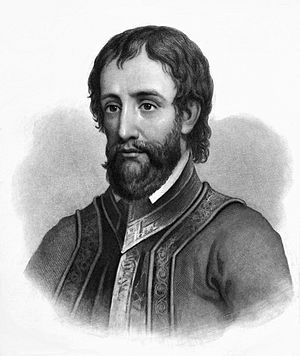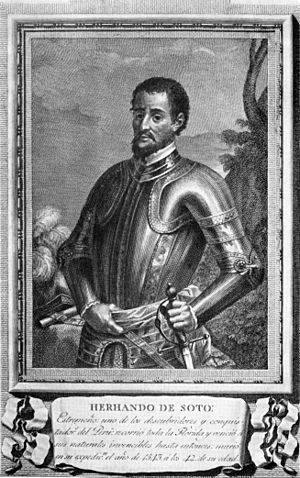Hernando de Soto facts for kids
Quick facts for kids
Hernando de Soto
|
|
|---|---|

An artist's idea of what Hernando de Soto looked like, published in 1858.
|
|
| Born | c. 1500 Jerez de los Caballeros, Crown of Castile
|
| Died | 21 May 1542 (aged about 41) Guachoya on the bank of the Mississippi River
|
| Occupation | Explorer and conquistador |
| Spouse(s) | Isabel de Bobadilla |
| Signature | |
 |
|
Hernando de Soto (born around 1500, died May 21, 1542) was a Spanish explorer and conquistador (a Spanish word for "conqueror"). He took part in expeditions in Central America and helped Francisco Pizarro in the conquest of the Inca Empire in Peru.
De Soto is most famous for leading the first major European expedition into what is now the United States. His journey took him through Florida, Georgia, the Carolinas, Tennessee, Alabama, Mississippi, and Arkansas. He was searching for gold and a route to China. He is also known as the first European to see and cross the mighty Mississippi River. De Soto died during this expedition in 1542.
Contents
Early Life and Adventures
Hernando de Soto was born around the year 1500 in Extremadura, a poor region of Spain. His parents were hidalgos, which meant they were nobles but did not have a lot of money. Like many young men of his time, de Soto wanted to find his fortune in other lands.
After Christopher Columbus sailed to the Americas, stories of gold and adventure spread across Spain. This inspired de Soto and others to travel to the "New World" to seek fame and riches. In 1514, when he was just a teenager, de Soto sailed to Panama with its new governor, Pedro Arias Dávila.
Joining Pizarro in Peru
In Central America, de Soto became known as a brave and skilled soldier. He was an excellent horseman and a clever tactician. In 1532, he took his own men and ships to join Francisco Pizarro on his expedition to conquer the Inca Empire in Peru.
Pizarro made de Soto one of his top captains. De Soto was the first to meet the Inca emperor, Atahualpa. Later, the Spanish captured Atahualpa and held him for ransom. His people paid by filling a large room with gold and silver. While he was a captive, de Soto became friendly with Atahualpa and even taught him how to play chess.
Despite the ransom, the Spanish leaders decided to execute Atahualpa. De Soto was away on a scouting mission when this happened. The Spanish then marched to the Inca capital of Cuzco, which they captured. The treasure they found there made de Soto a very wealthy man.
Expedition into North America
In 1536, de Soto returned to Spain as a rich man. He married Isabel de Bobadilla and was made the governor of Cuba by the King of Spain. He was also given the right to explore and colonize North America.
Inspired by stories from another explorer, Álvar Núñez Cabeza de Vaca, de Soto put together a large expedition. He gathered over 600 volunteers, priests, craftsmen, and farmers. They brought hundreds of horses and pigs, along with tons of equipment, for a four-year journey.
Historians have studied the journals of men who were on the expedition to figure out the exact path they took. They also use archaeology, finding artifacts left behind by the Spanish, to trace the route.
Landing in Florida
In May 1539, de Soto's nine ships landed on the coast of Florida, likely near what is now Tampa Bay. There, they had a lucky encounter. They found Juan Ortiz, a Spaniard who had been captured by a local tribe years earlier. Ortiz had learned the Native American languages and became a very important interpreter for the expedition.
The expedition traveled north through Florida. They often had violent conflicts with the Native American tribes they met. De Soto's army would take food from the villages and force local people to be their guides and carry their supplies. This created a lot of fear and anger among the native population. The first winter was spent in a village that is now the site of Tallahassee.
Journey Through the Southeast

In 1540, hearing rumors of gold, the expedition marched northeast into Georgia and the Carolinas. In what is now South Carolina, they were greeted by a powerful female chief, known as the The Lady of Cofitachequi. She gave them pearls and food, but they found no gold.
The expedition then turned west, crossing the Appalachian Mountains into Tennessee. They continued south into Alabama, where they met the powerful chief Tuskaloosa. When Tuskaloosa refused to give the Spanish supplies and people, de Soto took him hostage. Tuskaloosa led them to a fortified town called Mabila.
At Mabila, the Native Americans ambushed the Spanish. A huge, nine-hour battle followed. The Spanish burned the town, and a large number of Native Americans were killed. About 200 of de Soto's men also died or were badly wounded. It was a costly victory for the Spanish, as they lost most of their supplies and were left weak in a hostile land.
Reaching the Mississippi River
After the battle of Mabila, de Soto led his men into Mississippi to spend the winter. In the spring of 1541, they were attacked by the Chickasaw tribe.
On May 8, 1541, the expedition reached the Mississippi River. They were the first Europeans to see this great river. De Soto and his men spent a month building flatboats to cross it. After crossing, they explored what is now Arkansas, Oklahoma, and Texas.
Death of De Soto
The expedition suffered through another harsh winter. Their interpreter, Juan Ortiz, had died, which made it very hard to communicate with the native tribes.
On May 21, 1542, Hernando de Soto died from a fever near the Mississippi River. Luis de Moscoso Alvarado took command of the expedition.
What Happened After the Expedition?
The survivors, led by Luis de Moscoso, decided to end the expedition. They tried to walk to Mexico but had to turn back. They returned to the Mississippi River, built boats, and sailed down the river to the Gulf of Mexico. After a difficult journey, about 300 survivors finally reached a Spanish town in Mexico.
Legacy of the Expedition
Although the Spanish considered the expedition a failure because it found no gold, it had major effects on North America.
- New Animals and Diseases: The pigs brought by de Soto escaped and became the ancestors of the wild razorback hogs found in the southeastern U.S. today. More tragically, the Europeans carried diseases like smallpox and measles. The Native Americans had no immunity to these new illnesses, which caused terrible epidemics and killed many people in the areas the expedition crossed.
- Knowledge of North America: The journals from the expedition gave Europeans their first real information about the geography, plants, animals, and people of the Southeast. They are the only written records of what the great Mississippian culture was like before it disappeared.
- Strained Relations: The expedition's constant conflicts and harsh treatment of Native Americans created lasting hostility between Europeans and the native peoples of the region.
Places Named After De Soto
Many places and things have been named after Hernando de Soto. Here are a few examples:
- DeSoto County in Florida and Mississippi
- De Soto National Forest in Mississippi
- De Soto, a town in Missouri
- Fort De Soto Park in Florida
- The DeSoto, a car brand made by Chrysler
- The Hernando de Soto Bridge in Memphis, Tennessee
Interesting Facts About Hernando de Soto
- Three towns in Spain claim to be de Soto's birthplace: Badajoz, Barcarrota, and Jerez de los Caballeros.
- In his will, De Soto wanted to be buried in Jerez de los Caballeros. But the exact place where he is buried is not known. De Soto wanted the native people to believe he was a god. He called himself an "immortal Son of the Sun." After he died, his men wanted to hide his death. One story says de Soto's men wrapped his body in blankets, weighted it with sand, and sank it in the middle of the Mississippi River at night.
- DeSoto Site Historic State Park is in Tallahassee, Florida. It's a park meant to help research and teach about the area's history. This history starts with Hernando de Soto using the site as a winter camp in 1539.
- When he died, de Soto owned four Native American slaves, three horses, and 700 hogs.
See also
 In Spanish: Hernando de Soto para niños
In Spanish: Hernando de Soto para niños
Images for kids









